| Vintage Pulp | Apr 20 2021 |

For someone so big he didn't leave much of a trace.
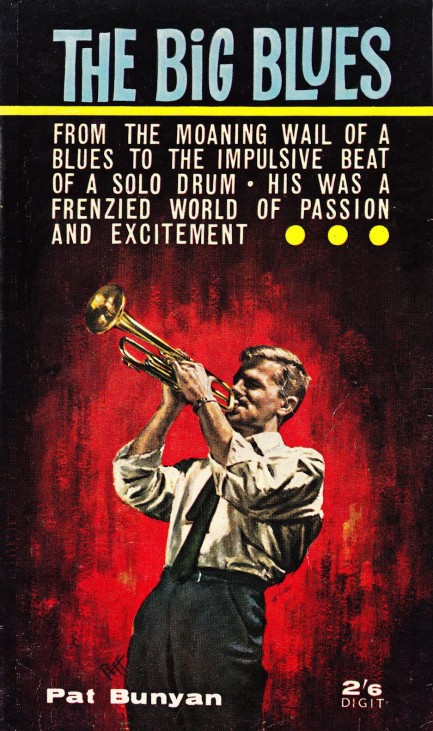
You'd think a guy named Bunyan would be a giant, at least figuratively, but after some deep searching we found no mention of Pat Bunyan associated with the mid-century jazz movement in any context other than that offered by the blurb on the back of the jazz oriented 1963 novel The Big Blues. The rear says, “Told by a man who blew the horn in many a night spot from the lowdown dive to way up there...” So you can see why we expected to find him mentioned as a major dude of the bop era. But we found no credits for him—way up there or anywhere, even on the comprehensive music site Discogs. Well regarded jazz players often—if not typically—played on albums as sidemen. No such indications exist for Mr. Bunyan. Of course, he could have performed under a pseudonym.
The Big Blues was originally published in the U.S. in 1958 by Newsstand Library, then again in 1960 as I Peddle Jazz by Saber Books, both low budget outfits that specialized in sleaze novels. That probably tells you all you need to know as far as Bunyan's literary talent goes. As far as confirming his identity, we had hopes when we saw he was referred to as Paul Porto on the U.S. edition. Maybe that was the name he used when he lit a firestorm in the American jazz scene. Maybe he had to change identity or be arrested for terrorism after blowing club after club sky high. To the far corners of the online realm we went and... nope. There's no evidence of a Paul Porto playing music during the mid-century jazz era.
As we've commented before, the internet is just an aperture and only about .000001% of all knowledge makes it through the opening. Someone has to actually take the time to do what we do here at Pulp Intl., which is decide the data is worthwhile to others and upload it. We're constantly uploading from sources we've purchased, for example from old tabloids. That makes us gatekeepers of sorts, and as members of that group we can tell you we're notoriously lazy, repetitive, and biased. But even if the gatekeepers don't do the best job getting all relevant data online, would the internet not have info on a great jazzman who played way up there? For that reason, we suspect Bunyan/Porto was just a hack author taking advantage of the jazz trend.
In any case, Digit saw something salable in The Big Blues and certainly elevated it when it produced its edition. The company often featured brilliant cover art—examples here, here, and here—and the front of this one was painted by the masterful Sam Peffer, aka Peff, who we've talked about a couple of times, notably here. So The Big Blues paperback ended up being more artful than its author probably ever expected, and thanks to its collectible nature survives today. As for Big Pat Bunyan, he wrote one other novel that used jazz as a backdrop, 1966's A Doll for Johnny Marco, then disappeared from the publishing scene. We're curious though. Which means we'll probably pick up one of his books if we find one at the right price.
Update: we received an e-mail with a scan of an item from the Hartford Courant newspaper of June 1957 containing an announcement about a concert by Pat Bunyan and his band. So Bunyan did exist. Corrections from readers are part of the package for bloggers, and we'd be nothing without them. So thanks for the e-mail. Now we'll definitely have to read one of Bunyan's books. In fact, we just ordered The Big Blues a few minutes ago.
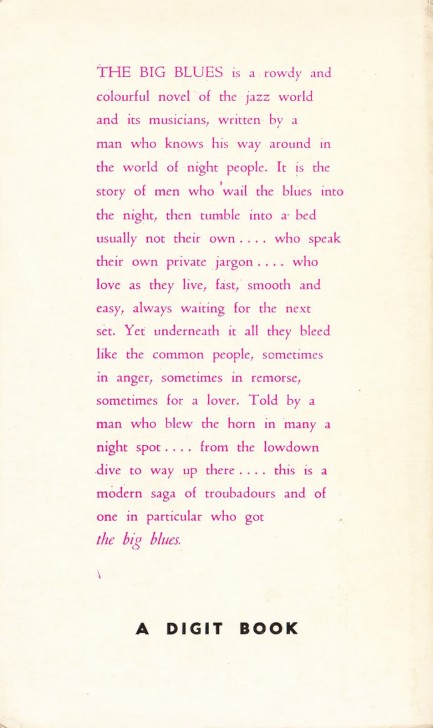
| Vintage Pulp | Apr 20 2021 |

Since you obviously don't get the point of why I'm wearing this, it's not so we can go outside.

This Technicolor lithograph is entitled “Prepared,” but while the model is prepared for hot fun and games, her off-frame male friend seems to want to go for a wet walk. Well, men can be dense. Once, the Pulp Intl. girlfriends dressed up sexy and gave us homemade coupons that said “Tonight—redeemable for anything you want,” and we made them watch the NFL division championships with us. Not what they had in mind, but anyone could make that mistake. Circa 1960 on this litho.
| Vintage Pulp | Apr 19 2021 |

Revenge is a dish best served with hot lead.

Above is a poster for the French-Italian western Une corde un Colt..., which in Italy was titled Cimitero senza croci and in English was known as Cemetery without Crosses. It premiered in France in January 1969, then opened in Italy today the same year. This falls into the spaghetti western category, with a mostly Italian crew shooting in Spain with actors from France, Spain, and Italy. But before we get too deep into the movie, we want to note that there's a brilliant title song performed by Scott Walker. If you don't know this musical legend, we highly suggest you familiarize yourself with his work. He was a genius who specialized in downbeat pop music that had a cinematic scope. We have all his albums, and they're all great.
The movie is a revenge tale in which French hottie Michèle Mercier seeks to punish the scoundrels who double-crossed and hanged her man. She appeals to her hubby's pal Robert Hossein—also the director and co-writer of this epic—who refuses until it becomes clear Mercier will take on the difficult task herself if she must. So Hossien agrees, and opts for the direct route to revenge by signing on with the enemy, then double-crossing the clan leader by kidnapping his daughter. This turns out to have unexpected consequences, but then that's the thing about revenge—it rarely goes as smoothly as hoped. Just ask Dick Powell.
As westerns go, this one has all the required elements—rickety old frontier town, unshaven steely-eyed villains, frilly saloon girls, and so forth. The genre also tends to feature repetitive visual gimmicks, and in this one Hossein always slips on a single black glove when he's about to ventilate someone. He's sort of a reverse Michael Jackson that way, except when he puts on the glove it's everyone else who starts to walk backwards. Ultimately, we suppose Cimitero senza croci asks whether it's better to move on from injustice, or risk one's figurative soul by seeking to personally balance the cosmic scales. It's not quite an Eastwood calibre western, but then again how could it be? For fans of the genre it'll go down like a smooth barroom whisky.


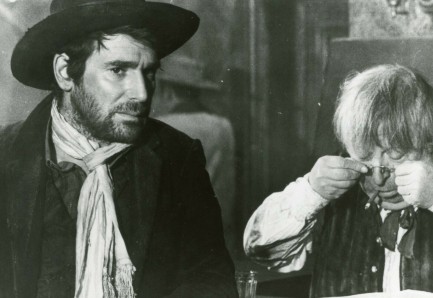
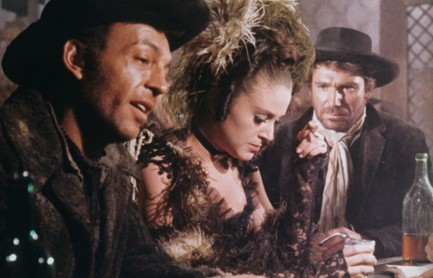
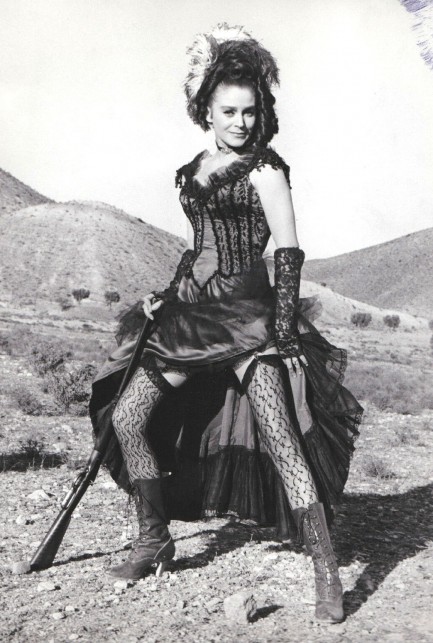

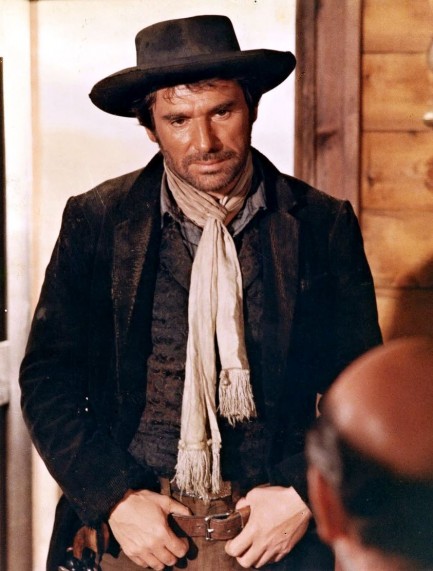
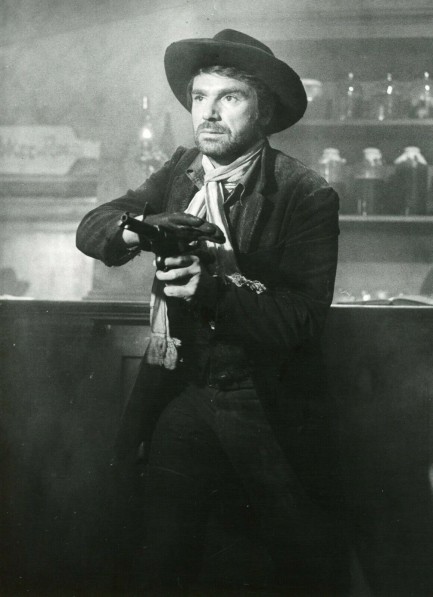

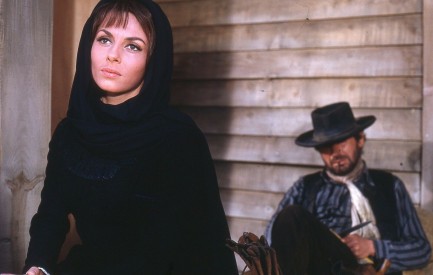

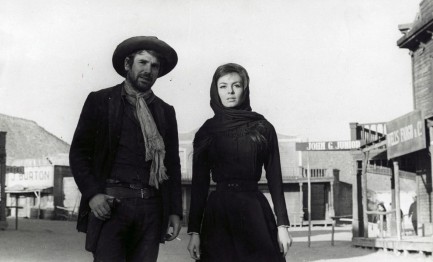












| Vintage Pulp | Apr 19 2021 |

Don't hate the Playa, hate the games.
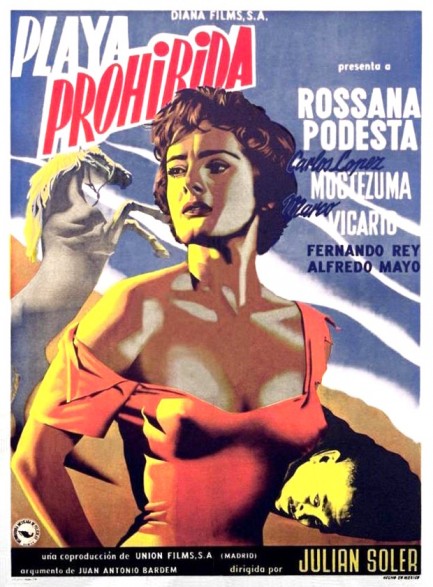

Playa prohibida was a Mexican-Spanish co-production filmed on Mallorca, starring Rossana Podesta, that premiered in Mexico today in 1956 and reached Spain the next year, in March 1957. Above are the Mexican and Spanish posters, both quite nice we think. They're differentiated by the fact that one gives second billing to Carlos López Moctezuma, who was Mexican, while the other gives second and third billing to Spanish actors Fernando Rey and Alfredo Mayo.
Podesta plays a woman living in a beach town, and everyone thinks she's daft. When she's found on the beach standing over a corpse and looking guilty, the cops want to pin the crime on her, but a screenwriter passing through takes up the mystery and—with the help of his story construction skills—tries to figure out what happened. He narrates a significant part of the film, but other characters apply voiceover too, including the allegedly mad Podesta. The puzzle is eventually solved, and as you'd expect it's layered with jealousy, greed, betrayal, and all the usual games.
If you're thinking this sounds a bit familiar, that may because the setting bears some resemblance to Podesta's 1953 Mexican made thiller La red, in which she was also a somewhat enigmatic woman living in a small seaside community. We suppose when Mexican filmmakers thought "exotic beach beauty" Podesta came to mind, and why not? Just look at her. Her presence alone makes Playa prohibida worth a viewing, at least for us. And possibly for you too. For the moment—i.e. while the link lasts—you can watch it on YouTube and decide for yourself. Spanish required.

| Vintage Pulp | Apr 17 2021 |

I really hope they keep this up. It's only when men are busy fighting over me that they leave me alone.
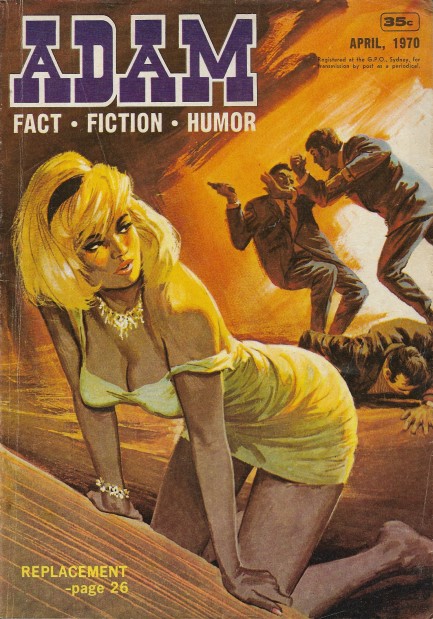

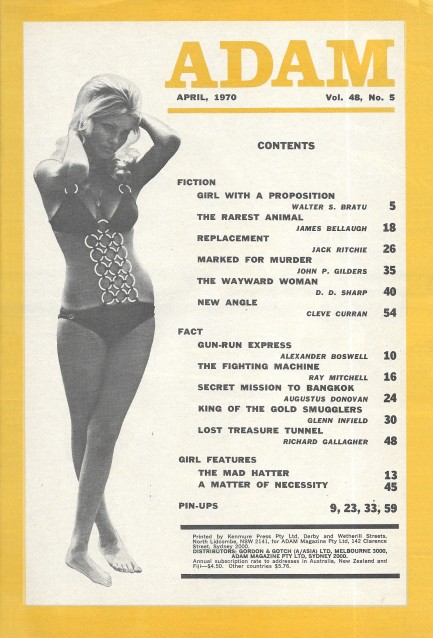
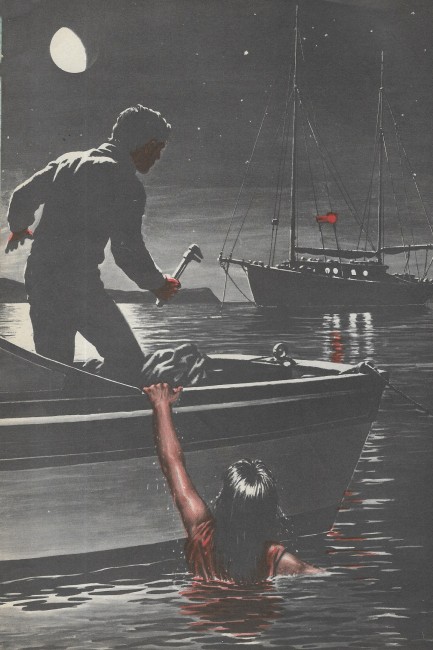
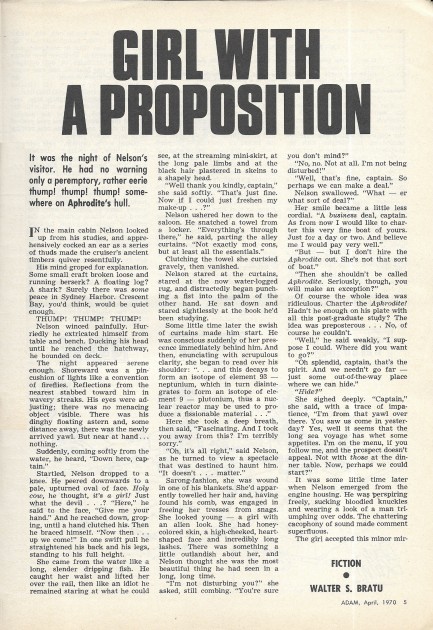

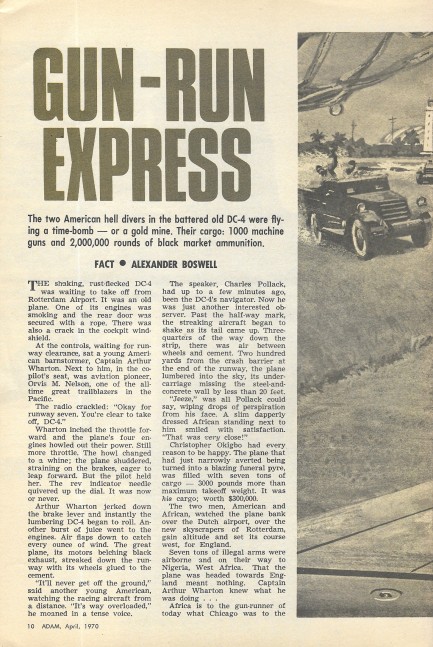
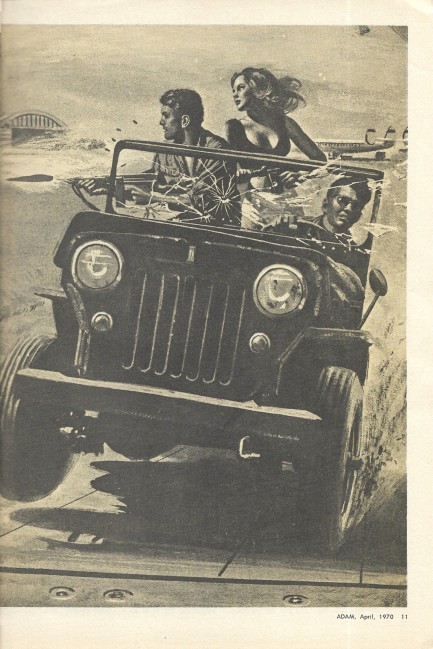
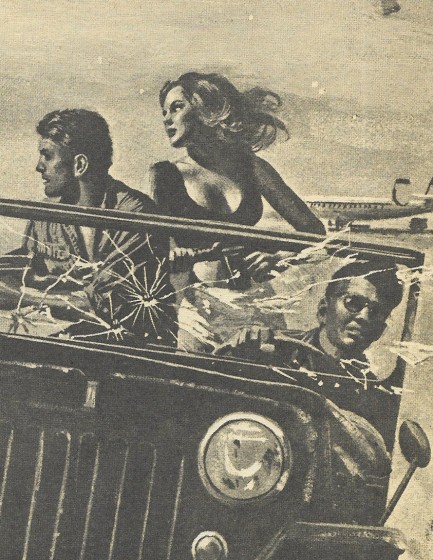
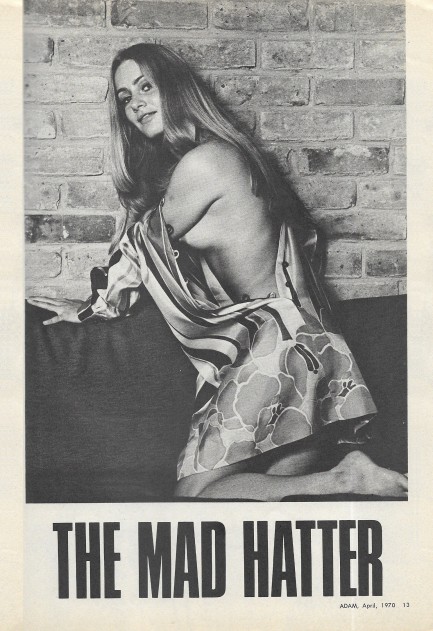



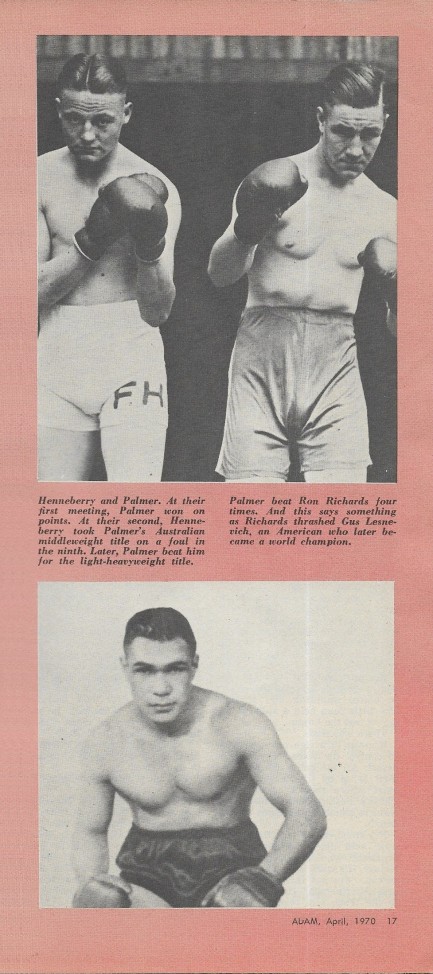
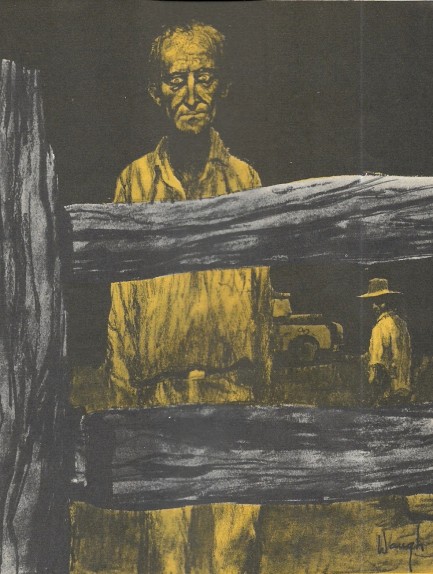

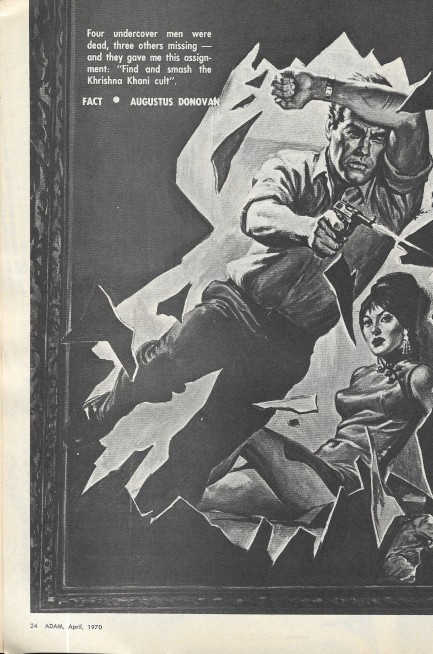
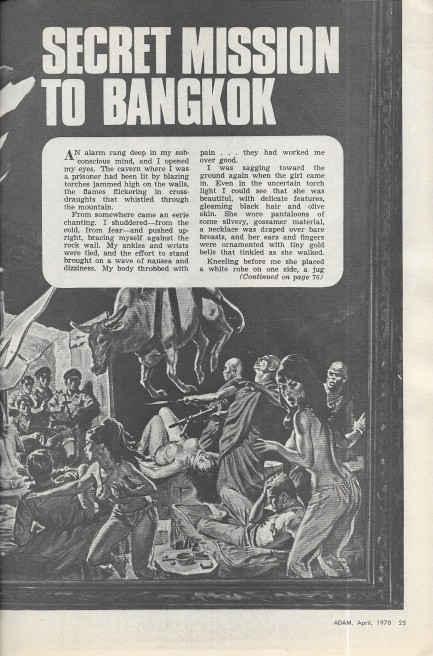
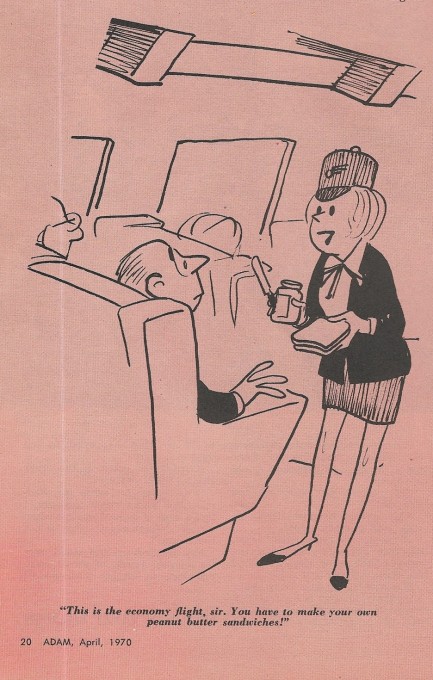

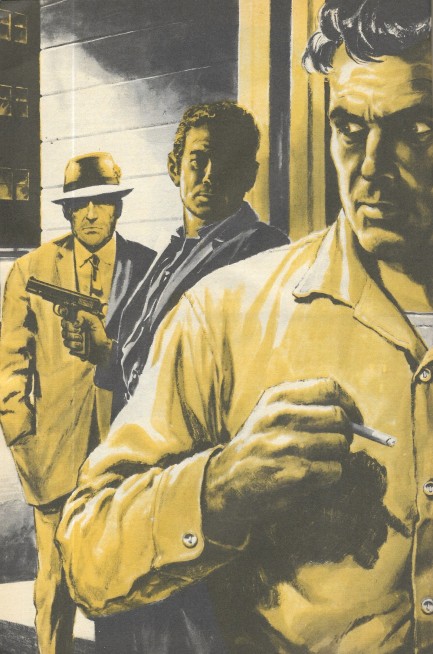
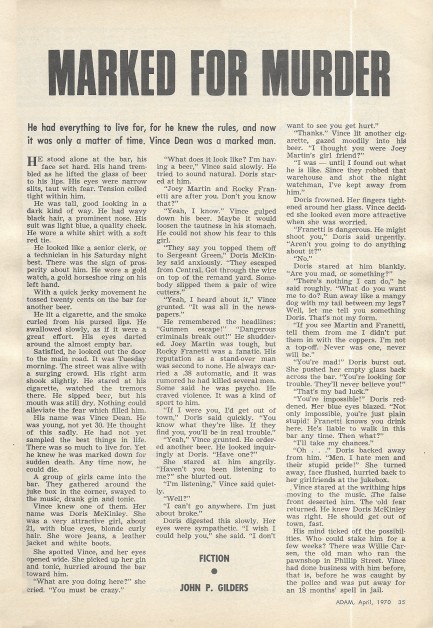



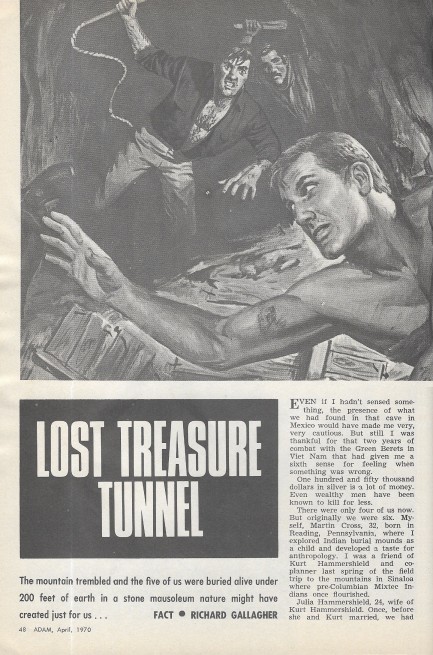
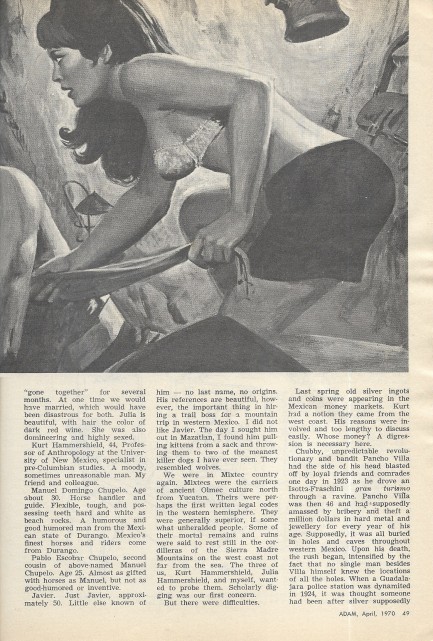

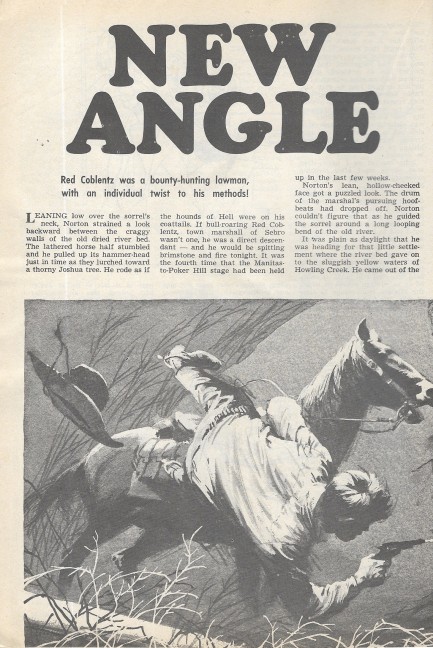
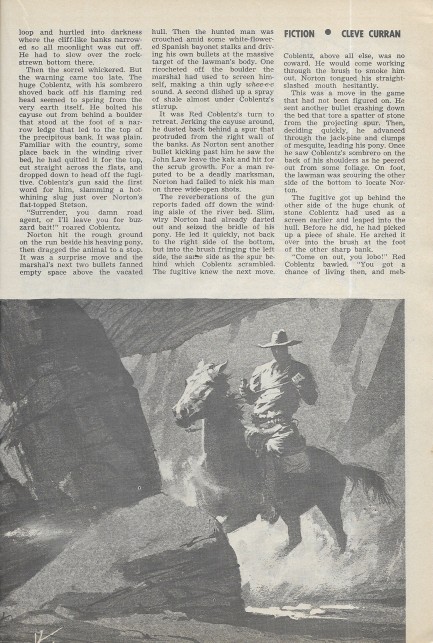

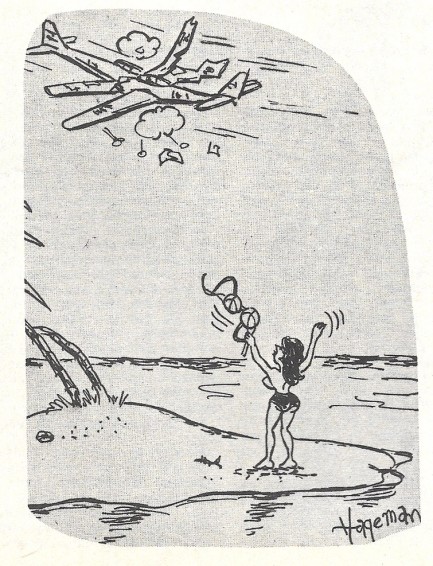

Above is another issue Adam magazine, published April 1970, with the type of cover art that is a trademark of the brand. It's pretty hard to keep thinking of quips for these when every cover features two or three men fighting and a femme fatale standing apart from the action. Somehow we've managed to do it sixty-eight times. Inside you get a signed illustration from Jack Waugh, numerous stories and models, and, just above, a slight variation on the time-honored desert island cartoon, a tradition we commemorated in exhaustive detail last year. Check here for fifty more examples.
| Vintage Pulp | Apr 16 2021 |

Crook and cop play hide and seek in Maurice Procter's Brit crime thriller.
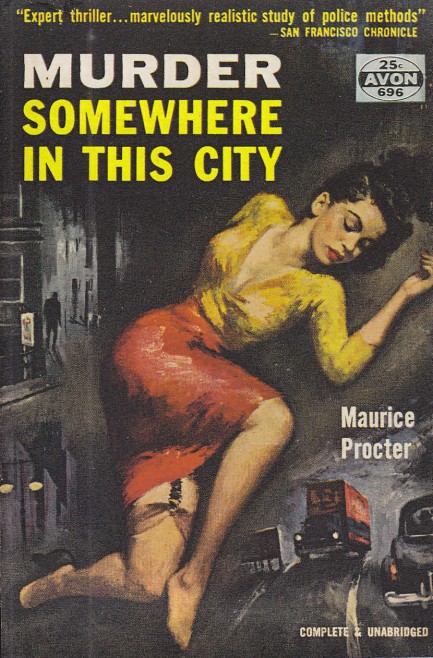
1954's Murder Somewhere in This City by Maurice Procter was originally published as Somewhere in This City, and it turns out it was the source material for a movie we saw last year called Hell Is a City. We didn't know that when we started the book. We just liked the cover (which it turns out is uncredited). The plot deals with a criminal and cop who have been enemies for so long their feud is personal. A robbery, a kidnapping, and a murder pit them against each other for what both suspect will be the decisive last time. But the cop has to actually find his nemesis, who's in hiding somewhere in the big city, making plans, achieving objectives, laying groundwork for his final escape overseas. The plot began to seem familiar pretty quickly, and no wonder the movie was good, because the book is too. Procter writes an entertaining story that is part detective procedural, part heist thriller, and part domestic drama. The film tracks it closely, which means you can find out more about the novel at our write-up on the movie here.
| Vintage Pulp | Apr 15 2021 |

That stocking she thought she lost? It's been under the bed the whole time.
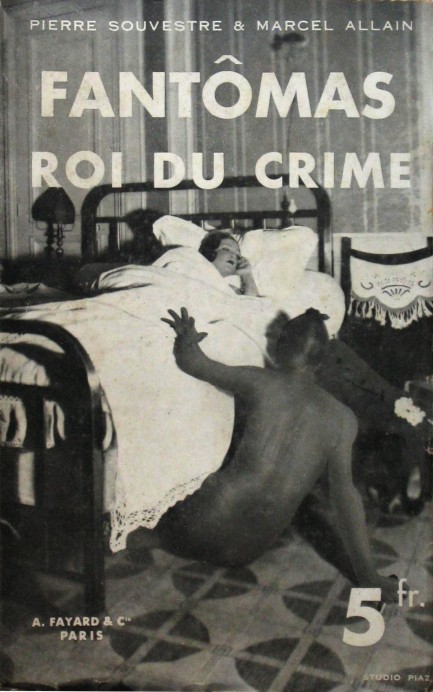
Above is a nicely terrifying cover for Pierre Souvestre and Marcel Allain's novel Fantômas roi du crime, a police saga starring the recurring character Fantômas, a ruthless master criminal. Souvestre and Allain first dreamt him up in 1911, and saw their creation adapted to television, cinema, and comics. This particular edition, fifteenth in the Fantômas series and published by Chez Arthème Fayard & Cie, is from 1933, but the novel originally appeared way back in 1912 as L'Evadée de Saint-Lazare. We may try this out if we can find a translation somewhere.
| Femmes Fatales | Apr 15 2021 |

Look! Down in the water. It's a fish. It's a submarine. It's super Joanne!

This fun shot of American model Joanne Arnold is from a famous underwater series by legendary photographer Peter Gowland, images from which were first published in Playboy magazine in 1955. We ran across a rare shot from the session in the Goodtime Weekly Calender of 1963, which we scanned and put online a long while back, and later found her again in two Technicolor pin-ups. So this great image of Arnold is her fourth appearance on our website, but probably not her last.
| Vintage Pulp | Apr 14 2021 |

Humphrey Bogart meets an immoveable object.
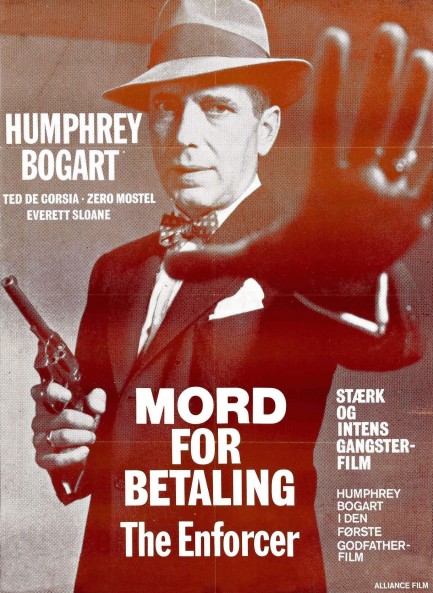
If you haven't seen Mord for betaling, better known as The Enforcer, you may want to add it to your queue. In addition to featuring yet another excellent Humphrey Bogart performance, it's a historical curiosity. Central to its plot is Murder, Inc., a group of killers-for-hire used by organized crime gangs. Murder, Inc. contracted anonymous killers for mob hits, leaving police with bodies but no motives and no suspects. In fact, the terms “contract” and “hit” were invented by Murder, Inc. The Enforcer is also of historical significance because showings featured a foreword in which Senator Estes Kefauver, chairman of the U.S. Senate Committee to Investigate Organized Crime, talked to the audience about the mafia, which the general public was just learning about at the time.
In the film Bogart plays a prosecutor who has been trying for years to bring down a crime boss named Albert Mendoza. When a witness dies, Bogart becomes aware of the existence of Murder, Inc. (though they aren't named that in the film), which to him seems like an impossibly bizarre idea. But he keeps uncovering more traces of the group until he finally believes. The rest of the film deals with his efforts to convince (or coerce) one of the cartel's members into being a witness in order to fry Mendoza. There are some twists and turns that force Bogart to shift gears more than once, and all of this is told in flashback, after the death of his stool pigeon, which happens in the first reel to set up the plot.
As we said, Bogart is solid as always, and he's helped greatly by Zero Mostel, who's quite good as a shaky potential witness. As far as the film as a whole goes, most vintage cinema fans consider it middling Bogart, but that's plenty good enough to warrant a look. The poster you see above, which we absolutely love, was made for Denmark, where the movie's title means, appropriately, “murder for payment.” We have several other posters for the film you can see at this link, and a cool Bogart promo photo that mirrors the above image, viewable at this link. The Enforcer premiered in the U.S. in 1951 and opened in Denmark today in 1952.
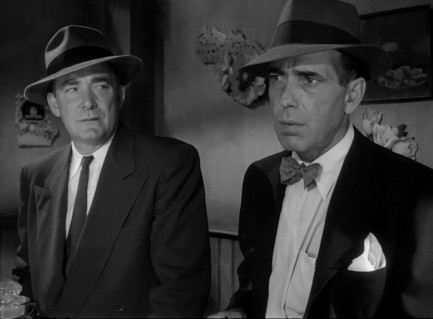 But I distinctly remember being told this was a bow tie-only affair.
But I distinctly remember being told this was a bow tie-only affair.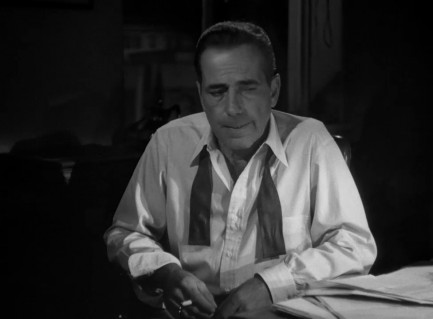 I guess not.
I guess not.| Vintage Pulp | Apr 14 2021 |

She's overworked, underpaid, unappreciated, and has no backup plan. Also there's that whole curse thing.

Can a working girl find happiness à la Pretty Woman? That's the eternal question asked by (Maruhi) jorô seme jigoku, aka The Hell-Fated Courtesan. An Edo-era geisha-turned-prostitute played by Rie Nakagawa is believed by superstitious locals to be cursed because some of those who've had sex with her died. Her only sort-of-friend in this dark existence is a perverted artist, and her pimp is of course cruel and untrustworthy. But eventually she meets a puppeteer to whom she offers herself romantically only to be rebuffed. Surprised, she intones, “This is not an ordinary guy.” She's right. He refused her because he thinks he can only be turned on if a woman looks like one of his puppets, but when he finally samples some of that sweet Nakagawa he changes his mind about that and offers to take her with him to Osaka, where her problems and alleged curse will be behind her. Will she go? Will she be allowed to go? Will fate cut her a break? Pertinent questions all.
In 1973 Nikkatsu Studios' roman porno line had not yet jumped the shark, which means (Maruhi) jorô seme jigoku resembles a normal film in most ways. Its plot is basically linear, though it contains one framing segment; its sexual content is perverse, though not pointlessly misogynistic; and its humor generally works. In fact, there are some truly funny moments in this, such as when Nakagawa lets a carp suck her nipples. We won't even bother to describe what direction that scene goes. Later she slices off a dead man's finger and masturbates with it. Afterward she tells the finger that, though its former owner was a scoundrel and a snake, he will now go to heaven. That's some magical pussy. Maybe Nakagawa isn't cursed after all. Maybe she just embodies male insecurities and fears and they punish her as a result. And if that's true, maybe there is a Pretty Woman ending for her. But you never know. One character observes that a woman's heart is unpredictable and terrifying. (Maruhi) jorô seme jigoku tries to prove that adage true. It premiered in Japan today in 1973










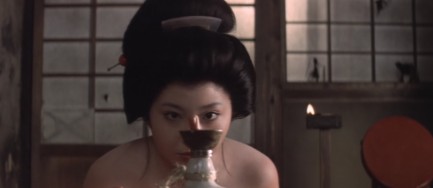

 |
 |




































































